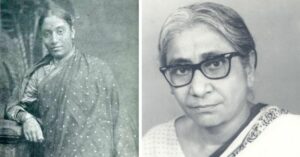Chandigarh to CERN: Meet the Indian Woman Who Helped Discover the ‘God Particle’
In an era where girls were not allowed to attend college, let alone work, Manjit Kaur of Panjab University was accepted at CERN, one of the world's largest and most respected centres for scientific research.

Social norms and patriarchy in Indian society are the major factors behind India’s significantly low female labour force. As per the International Labour Organisation, despite an increase in economy and income, women comprise only 27 per cent of the country’s total working population.
As per experts, occupational sorting (where certain professions are stereotypically believed to be for a particular gender) can also restrict women in taking up professions considered male, such as those in science, math and technology. This theory has statistical support that states that only 14 per cent of Indian researchers are women.
Considering that the statistics represent recent times, one can only fathom what the condition might have been five decades ago. In an era when girls were not allowed to attend college, let alone work, there existed rare parents who encouraged their daughters to pursue education and make a room and therefore, an identity of their own.
Manjit Kaur, a Research Associate at CERN (the European Organization for Nuclear Research), is from Chandigarh, considers herself blessed to be born in a family that gives utmost importance to academia.

My parents staunchly believed that sons and daughters had equal rights to follow their passion and academics, an important tool to reach the end goal, Kaur tells The Better India in an exclusive interview.
An inclination towards science runs in her family. While Kaur’s father is an engineer, her four siblings are either pursuing engineering or doctoral studies.
A curiosity about how the universe functions and a fascination for quantum mechanics helped Kaur bag a scholarship from the Council of Scientific and Industrial Research (CSIR). She could use the opportunity to do her PhD in Physics from Panjab University (PU) in the 70s.
Kaur entered the teaching profession after her doctorate. She worked at the MCMDAV College in Chandigarh as a Lecturer for three years and then joined PU as a Senior Lecturer. In 1989, life took a turn when she was accepted at CERN, one of the world’s largest and most respected centres for scientific research.
There’s an interesting trivia about how the professor ended up at CERN. In her own words:
“In 1988, a Professor from CERN came to deliver a talk at the department and was looking for students to join a project under World Laboratory. I recommended two students. A couple of months later, in August 1988, I went to present a paper at the ICHEP conference in Munich, Germany. The same professor met and persuaded me to join the same project. Soon, I received an offer letter. Finally, I joined in November 1989 after getting study leave from the University.”
Working On A Path-Breaking Project
In 2013, the Nobel Prize in Physics was awarded jointly to François Englert and Peter W Higgs “for the theoretical discovery of a mechanism that contributes to our understanding of the origin of mass of subatomic particles”.
Also known as God particle, the Higgs particle is one of the 17 particles in the Standard Model, the model of physics which describes all known basic particles. The Higgs particle is a boson. Bosons are thought to be particles which are responsible for all physical forces (except gravity). Other known bosons are the photon, the W and Z bosons, and the gluon.
Four teachers, including Manjit Kaur and ten PhD students from PU, were a part of this notable experiment that worked at the Large Hadron Collider (LHC) in a tunnel at the Geneva Laboratory in Switzerland.
The discovery opened a plethora of possibilities, including that of an alternative universe, and answered questions about particle physics.
CMS experiment at CERN has been one of the most complex precision experiments which has successfully discovered the HIGGS Boson. It has been a great experience to work for this experiment, the 65-year-old says.
She has also worked on the L3 experiment at CERN, which focused on the study of electron-positron interactions at LEP (Large Electron Positron) Collider. It is a machine that is used for basic research in particle physics. The LEP was shut down in early 2000, and in the same tunnel, LHC was built. In this experiment, she was the only participant from PU.
Currently, Kaur is working on the Compact Muon Solenoid (CMS), which is a particle physics detector built on the LHC at CERN. She is involved in hardware responsibilities and participation in day-to-day service work which involves data taking shifts, test beam shifts etc.
The journey from PU to CERN had several ups and downs.
Entering an extremely competitive scientific world was challenging in the beginning. There were very limited means of communication with family in India during those days, especially with my husband, who was in Madhya Pradesh at the time. Fortunately, it did not take much my time in settling and getting accustomed to the work culture at CERN, she says.
She also resolved her limited knowledge of computing and improved it significantly by undertaking a Master of Computer Applications course from Indira Gandhi National Open University.
Staying away from family, travelling back and forth to India, and creating her own niche in the world of science was not a cake walk for Kaur. But instead of quitting, she continued to smash stereotypes and pushed all her limitations.
We, at The Better India, are proud of Manjit Kaur’s achievements and wish her the best in future endeavours!
Image Courtesy: Manjit Kaur
Also Read: Indian-Origin Scientist Co-Finds Water on Peanut-Shaped Asteroid, Itokawa!
(Edited by Shruti Singhal)
Like this story? Or have something to share?
Write to us: [email protected]
Connect with us on Facebook and Twitter.
This story made me
-
97
-
121
-
89
-
167
Tell Us More
We bring stories straight from the heart of India, to inspire millions and create a wave of impact. Our positive movement is growing bigger everyday, and we would love for you to join it.
Please contribute whatever you can, every little penny helps our team in bringing you more stories that support dreams and spread hope.



















